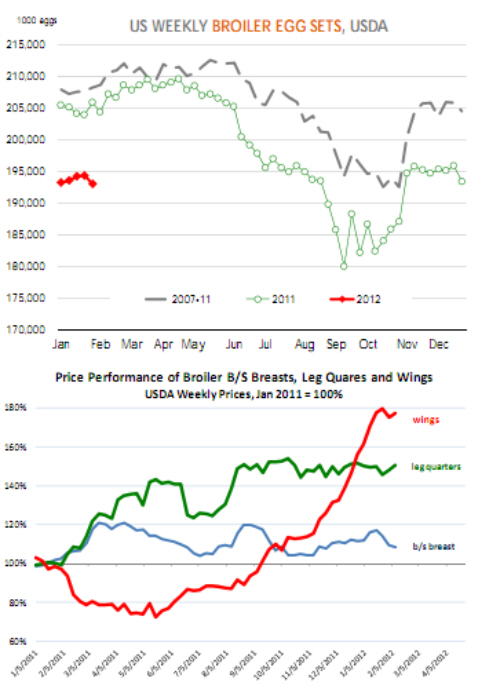



CME: Egg Sets & Chicken Placements Down from 2011
US - This may be called the Daily Livestock Report but as cattle and pork producers have known for the past 20 years, what happens with chicken directly affects the price they get for the hogs and cattle they bring to market, write Steve Meyer and Len Steiner.
Much of the talk
about demand in recent months has focused on a) the impact
that exports markets have had on beef and pork prices via reductions in US per capita disappearance b) what price are US
consumers willing to pay given ongoing economic troubles and
the fact that as much as 18% of the US population is either unemployed or underemployed. The question that is heard often
is: how high is high enough and at what point do consumers give
up and decide to stop going to the back of the store and head for
the pasta isle.
In our January 24 and 25 reports we went over
the demand issues for the various species and will not belabor
the point here or go back to reviewing Econ 101. Rather it is
important as we consider the path for beef and pork prices going into the all important March and April period to keep an eye
on broiler production and overall meat protein availability during the spring and summer months.
So far, broiler producers have been able to not only cut
back sharply but also sustain those reductions for a relatively
prolonged period of time.
The latest data shows egg sets for the
week ending February 4 were down 6.2% from the previous year
and they were 7.3% lower than the five year average. Since the
beginning of the year egg sets have been on average about 5.5%
lower than the previous year.
Chick placements since the start
of the year are down about 4% compared to a year ago. This
implies that overall chicken production will remain well below
year ago levels at least through the end of Q1 and very likely
into Q2. Indeed, given sharp reductions in the hatching flock,
most analysts now expect broiler production in 2012 to be lower
than the previous year.
The impact of the cutbacks in broiler
production has not been uniform on chicken prices. Whole bird
prices are somewhat higher compared to a year ago but any
price inflation for whole birds remains somewhat limited at this
point. Prices for boneless skinless chicken breasts also have not
increased as much as one would expect and current prices are
about 8% higher compared to January 2011.
One factor that
continues to negatively impact the chicken breast market, in our
view, is the slow recovery in the foodservice business. While
reports are that foodservice demand may have turned a corner
we still think the recovery there will take time given high rates
of unemployment. As a result, chicken companies still have too
many loads of chicken breast that they need to move in the spot
market, keeping prices in check. On the other hand, prices for
leg quarters are up some 51% and wings have jumped some 80%
compared to a year ago, trading at record high levels.
Profits in
the industry are slowly returning but they are tenuous at best
and highly dependent on keeping supplies in check.









